Family : Pomacentridae

Text © Giuseppe Mazza

English translation by Mario Beltramini
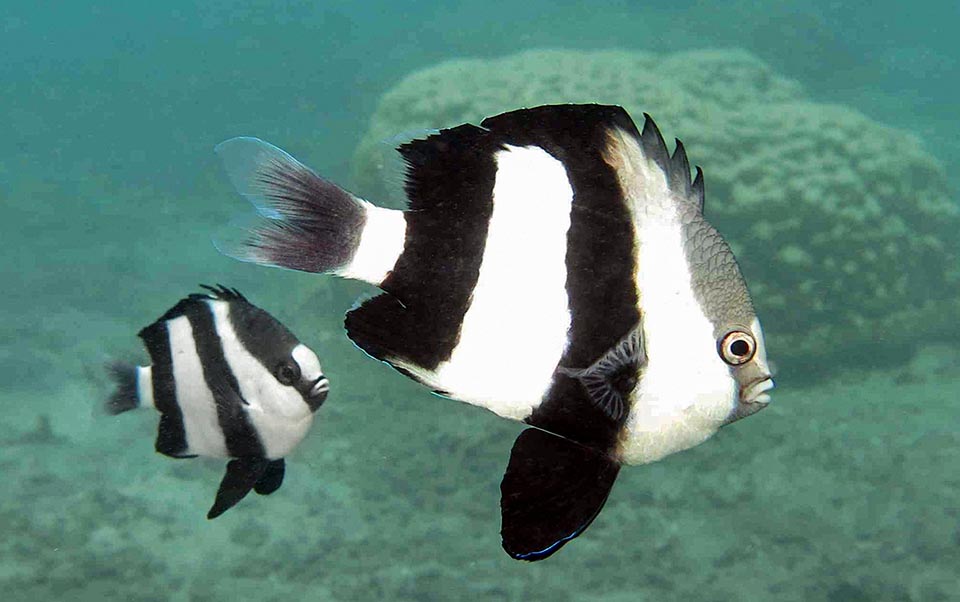
Dascyllus abudafur is present in the Red Sea and in the tropical and subtropical waters of the Indian Ocean up to Sumatra and the Java Sea © Jean-Marie Gradot
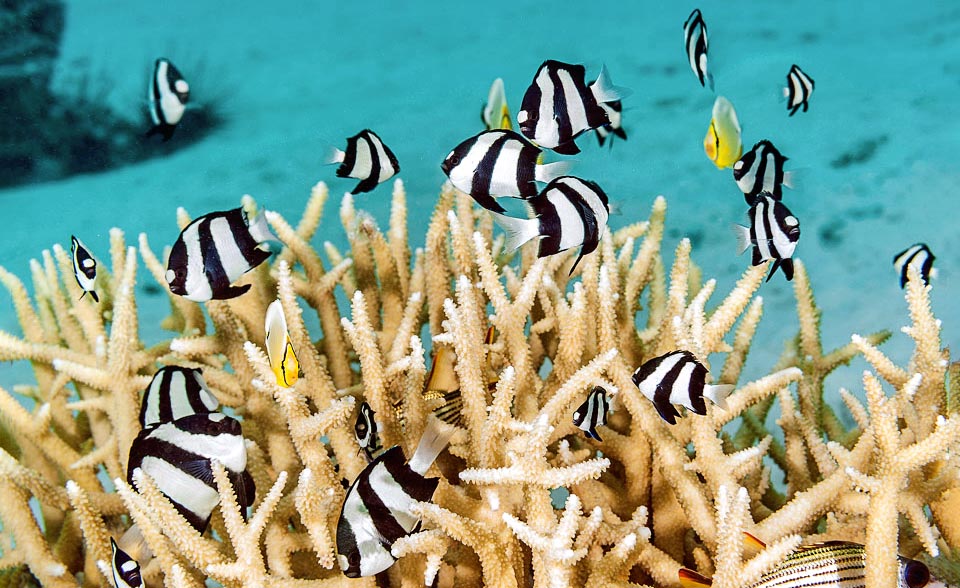
Towards East, in Pacific, lives instead Dascyllus aruanus, species now considered sister and here represented, that distinguishes for the caudal fin and the zone near the peduncle of a translucent luminous white, whilst Dascyllus abudafur, as can be noted in the photo on top, the caudal fin is usually black or greyish © François Libert
Dascyllus abudafur (Forsskål, 1775) known as Indian Ocean humbug belongs to the class of the Actinopterygii, the fishes with the rayed fins, to the order of the Perciformes and to the family of the Pomacentridae that counts 30 genera and more than 400 species, among which the well known clownfishes. The name of the genus Dascyllus, comes from the Greek “δάσκιλλος” (daskillos), a fish mentioned by Aristotle, whilst the specific term abudafur is simply the Arabic name of the fish.
Dascyllus abudafur is present in the Red Sea and in the tropical and subtropical waters of the Indian Ocean, up to Thailand, to Malaysia, Sumatra and Java Sea.
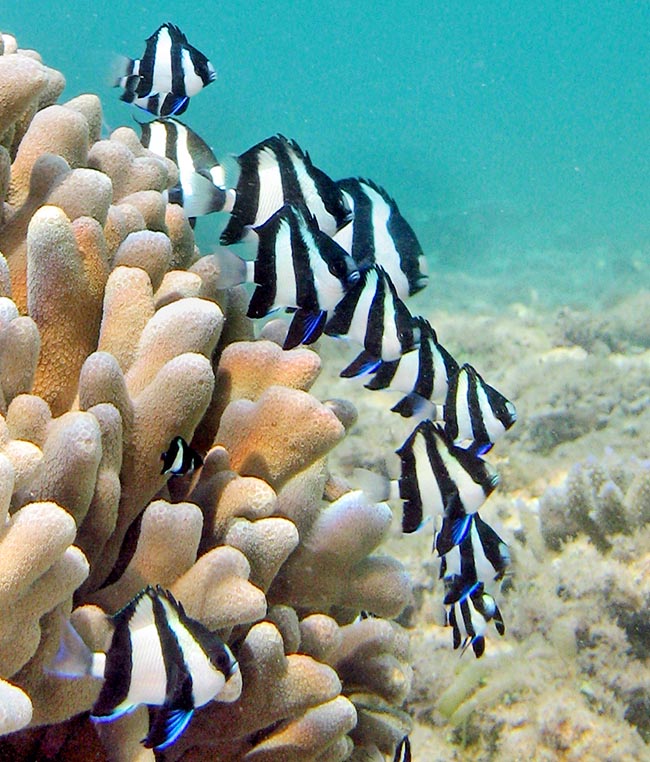
Dascyllus abudafur lives in schools formed by an alfa male with a small harem that defends a madrepore rich in caches. At times, in presence of big madreporic formations, these communities may merge in groups of 30-40 individuals with more males and large females controlling the boundaries of a territory © Jean-Marie Gradot
Ecology-Habitat
The Indian Ocean humbug goes swimming even in half a metre of water never going down, usually, under 12 m.
It is almost always found close to madrepores rich in ramifications and caches, like the Pocillopora damicornis, present in almost all its range, or species of the genus Acropora with sharp spikes that discourage predators.
Morphophysiology
Dascyllus abudafur is a small fish that does not exceed 10 cm with a squat appearance and with a high and arcuate back and protruding belly.
The background colour is white with three wide mimetic vertical black bands merging on top of the dorsal fin, indented in the first 3-5 rays.
The first band masks the eye and the muzzle apart a big circular spot between the eyes; the second stands at the level of the pelvic fins, also black with a blue electric fore edge; the third part by the anal fin, also having a thin blue electric edge, and covering the first part of the caudal peduncle reaches the zone with soft rays of the dorsal.
The first part of the caudal fin and that close to the caudal peduncle, just after the white band, are blackish grey and this distinguishes the species of Dascyllus aruanus of the Pacific, who has the caudal white and translucent.
However, we have to note that this is not an entirely reliable detail as also some Dascyllus aruanus may have the caudal with light greyish tones. What matters today is the molecular analysis that separated the two species.
Like many fishes, Dascyllus abudafur finally has a mimetic night livery where the frontal white spot disappears, getting black and the white parts partially assume purplish-brown hues.
Ethology-Reproductive Biology
The Indian Ocean humbug is a diurnal species nourishing of plankton, small invertebrates and algae, without ignoring, when it’s the case, the eggs of the other fishes, including larvae and fry. It usually lives in schools of up to 8 individuals that control a small territory.
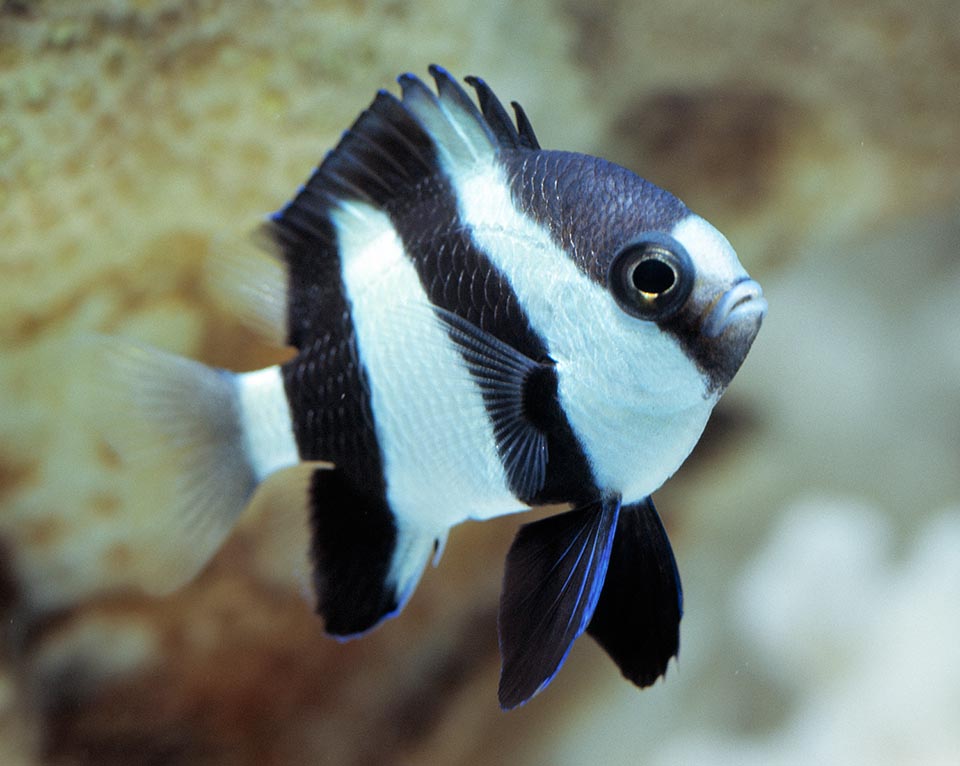
Dascyllus abudafur can reproduce all the year. The alfa male chooses carefully on the bottom a place suitable for the nest and catches the attention of the females ready to lay dancing up and down in the overhanging column of water. Then, completed the fecundation, keeps watch until hatching to a nest overflowing of eggs © Giuseppe Mazza
This is defended by an alfa male with a hierarchically organized harem depending on the size, but are found in even more consistent groups with 30-40 individuals and several males watching over the borders, at times helped also by the biggest females. On the other hand Dascyllus abudafur is a hermaphrodite proterogynyc species, with females that can transform into males while growing.
For the reproduction, that may occur all over the year, the alfa male chooses carefully on the bottom a place suitable for the nest and catches the attention of the females dancing up and down in the overhanging column of water with rapid movements. That is the signal awaited by the females ready to lay.
It mates first with the alfa one and then with the others, thus keeping watch to a nest overflowing with eggs that it defends against intruders until they hatch.
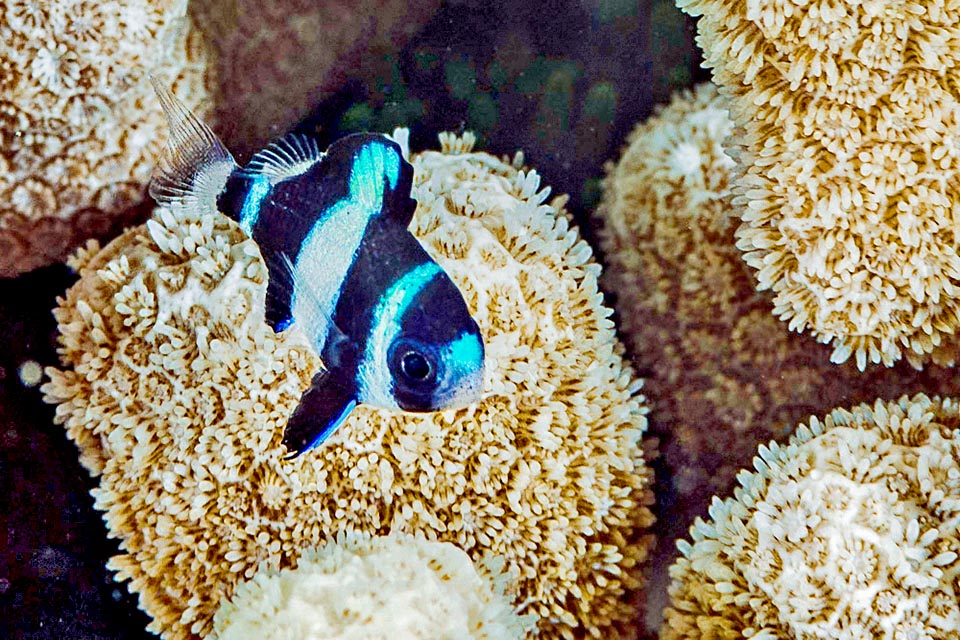
The juveniles resemble adults but the dorsal fin is proportionally higher and different, with the spiny rays forming a triangle © François Libert
The larval life lasts little more than 20 days and the post larvae are mainly black. Then, growing, appear with light blue hues; the characteristic bands and the young, who move together in order to reduce the risk of predation, colonize a protective madrepore having no guests, conspecifics included, who might attack them. Their livery assumes a little at the time, the look of the adults, but the dorsal fin is different: triangular and higher in the spiny rays and with soft rays clearly higher than the last spiny ray.
Inexpensive, robust and easy to feed, Dascyllus abudafur is a frequent guest of the domestic aquaria and is not an endangered species. The populations decimated by the events can double their members in less than 15 months and the fishing vulnerability index marks only 19 on a scale of 100.
Synonyms
Chaetodon abudafur Forsskål, 1775.
→ For general information about FISH please click here.
→ For general information about BONY FISH please click here
→ For general information about CARTILAGINOUS FISH please click here.
→ To appreciate the BIODIVERSITY of BONY FISH please click here.
→ To appreciate the BIODIVERSITY of CARTILAGINOUS FISH please click here.
